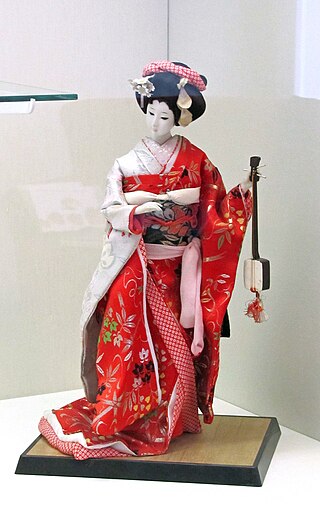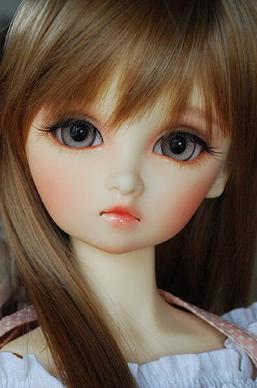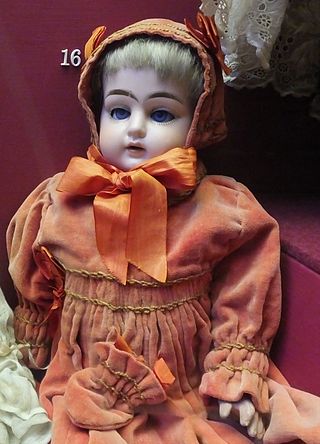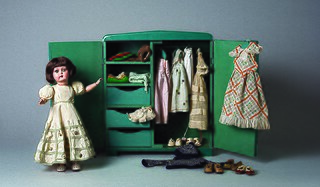
A doll is a model typically of a human or humanoid character, often used as a toy for children. Dolls have also been used in traditional religious rituals throughout the world. Traditional dolls made of materials such as clay and wood are found in the Americas, Asia, Africa and Europe. The earliest documented dolls go back to the ancient civilizations of Egypt, Greece, and Rome. They have been made as crude, rudimentary playthings as well as elaborate art. Modern doll manufacturing has its roots in Germany, from the 15th century. With industrialization and new materials such as porcelain and plastic, dolls were increasingly mass-produced. During the 20th century, dolls became increasingly popular as collectibles.
An action figure is a poseable character model figure made most commonly of plastic, and often based upon characters from a film, comic book, military, video game or television program; fictional or historical. These figures are usually marketed toward boys and adult collectors. The term was coined by Hasbro in 1964 to market G.I. Joe to boys.

A bobblehead, also known by nicknames such as nodder, wobbler, or wacky wobbler, is a type of small collectible figurine. Its head is often oversized compared to its body. Instead of a solid connection, its head is connected to the body by a spring or hook in such a way that a light tap will cause the head to move around, or "bobble", hence the name.

Japanese dolls are one of the traditional Japanese crafts.

A ball-jointed doll is any doll that is articulated with ball and socket joints. In contemporary usage when referring to modern dolls, and particularly when using the acronyms BJD or ABJD, it usually refers to modern Asian ball-jointed dolls. These are cast in polyurethane synthetic resin, a hard, dense plastic, and the parts strung together with a thick elastic. They are predominantly produced in Japan, South Korea and China. The BJD style has been described as both realistic and influenced by anime. They commonly range in size from about 60 centimetres (24 in) for the larger dolls, 40 cm (15.5 in) for the mini dolls, and down to 10 cm (4 in) for the very smallest BJDs. BJDs are primarily intended for adult collectors and customizers. They are made to be easy to customize, by painting, changing the eyes and wig, and so forth.

A Snow Baby is a small figurine, usually of a child, that depicts some aspect of the Christmas holidays or of winter sports. The traditional snow baby is made of unglazed biscuit porcelain and shows a child dressed in a snowsuit; the suit itself is covered in small pieces of crushed bisque, giving the appearance of fallen snowflakes. Figurines of other characters were also made, including Santa Claus, elves and animals such as penguins and polar bears.

A china doll is a doll made partially or wholly out of glazed porcelain. The name comes from china being used to refer to the material porcelain. Colloquially the term china doll is sometimes used to refer to any porcelain or bisque doll, but more specifically it describes only glazed dolls.

"Parian" is a term misapplied to a type of bisque shoulder head dolls manufactured primarily in Germany in the last quarter of the 19th century, from around 1860 to 1880. The origin of the term "parian" comes from the white marble from the island of Paros. The proper descriptive term for these dolls is "bisque". These shoulder head dolls have a body made from fabrics and a head created from very lightly tinted or untinted white porcelain. Unlike the china doll however, the bisque doll's head is not dipped in glaze before firing and as such has a matte finish, giving it a markedly different appearance. The UFDC still perpetuates the incorrect definition of these dolls is as follows: "Parian doll: doll made of fine white bisque without tinting. The features, hair and cheeks may be painted." Many collectors now are discarding the term parian in favor of untinted bisque versus tinted bisque.

A reborn doll is a hand made art doll created from a blank kit or a manufactured doll that has been transformed by an artist to resemble a human infant with as much realism as possible. The process of creating a reborn doll is referred to as reborning and the doll artists are referred to as reborners. Reborn dolls are also known as lifelike dolls or reborn baby dolls.

Pierre-François Jumeau, was the founder of Jumeau. Jumeau was an 1840s French firm that produced bisque dolls and china dolls. His second son Emile-Louis Jumeau, born in 1843, began assuming management of the company in the 1870s.

Jumeau was a French company, founded in the early 1840s, which designed and manufactured high quality bisque dolls.
Mildred Seeley was a doll collector, doll-related entrepreneur, and prolific author on the subjects of doll making and doll collecting.

A bisque doll or porcelain doll is a doll made partially or wholly out of bisque or biscuit porcelain. Bisque dolls are characterized by their realistic, skin-like matte finish. They had their peak of popularity between 1860 and 1900 with French and German dolls. Bisque dolls are collectible, and antique dolls can be worth thousands of dollars. Antique German and French bisque dolls from the 19th century were often made as children's playthings, but contemporary bisque dolls are predominantly made directly for the collectors market.

A composition doll is a doll made partially or wholly out of composition, a composite material composed of sawdust, glue, and other materials such as cornstarch, resin and wood flour. The first composition dolls were made in the 19th century.

The Judges' Lodgings, formerly a town house and now a museum, is located between Church Street and Castle Hill, Lancaster, Lancashire, England. It is recorded in the National Heritage List for England as a designated Grade I listed building. The building is the oldest existing town house in Lancaster, and was also the first house in Lancaster to have shutters. It was used by judges when they attended the sessions of the Assize Court.

Kewpie is a brand of dolls and figurines that were conceived as comic strip characters by cartoonist Rose O'Neill. The illustrated cartoons, appearing as baby cupid characters, began to gain popularity after the publication of O'Neill's comic strips in 1909, and O'Neill began to illustrate and sell paper doll versions of the Kewpies. The characters were first produced as bisque dolls in Waltershausen, Germany, beginning in 1912, and became extremely popular in the early 20th century.
Lenci dolls are wool felt dolls that feature heat-pressed wool faces with painted features. They typically have intricately made wool and organdy clothing, adorned with elaborate felt flowers, hats, and/or accoutrements. They are at the top end of the luxury goods market. Today they are considered highly prized collectibles.

Armand Marseille was a company in Köppelsdorf, Thuringia, Germany, that manufactured porcelain headed (bisque) dolls from 1885 onwards.

Ernst Heubach was a company in Köppelsdorf, Thuringia, Germany, that manufactured porcelain-headed bisque dolls from 1885 onwards

Marilú was an Argentine composition doll produced between 1932 and 1960, considered the most prominent and enduring doll in the country, and an icon in the history of national toys. It was created by Alicia Larguía, who was inspired by the French predecessor of Bleuette, a doll available through the famous magazine for girls La Semaine de Suzette. Seeking to replicate this model, Larguía launched Marilú in association with Editorial Atlántida, which was responsible for publishing advertisements and clothing patterns for the doll in its children's magazine Billiken, the most widely distributed in Latin America at the time. In view of the doll's immediate success, Atlántida also published a weekly magazine for girls, Marilú, between 1933 and 1936. The doll was originally imported from Germany, manufactured by the firm Kämmer & Reinhardt. Sometime between 1935 and 1936, Larguía changed suppliers and began to order the dolls from König & Wernicke, which was also German. During its first two years, Marilú was sold in an Atlántida store in Buenos Aires. The doll was sold along with a variety of other products, such as clothing, accessories and furniture. In 1934, Larguía became independent from the publishing house and opened her iconic store—Casa Marilú—on Florida Street, which in addition to selling the doll and its accessories, functioned as a prestigious prêt-à-porter fashion house for girls and young women.


















